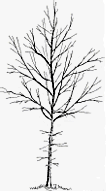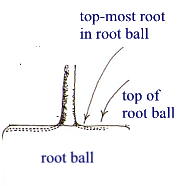Home > Nursery tree production > Specifications/standards > Sample nursery stock specifications
Sample nursery stock specification for shade trees
(This is an example that can be modified to meet your needs and site conditions)
Edward F. Gilman, Professor, Environmental Horticulture Department
University of Florida Gainesville
egilman@ufl.edu

 1) There shall be no roots greater than 1/10 diameter of the trunk circling more
than one-third the way around in the top half of the root ball. Roots larger
than this may be cut provided they are smaller than one-third the trunk diameter.
There shall be no kinked roots greater than 1/5 the trunk diameter. Roots larger
than this can be cut provided they are less than one-third the trunk diameter.
1) There shall be no roots greater than 1/10 diameter of the trunk circling more
than one-third the way around in the top half of the root ball. Roots larger
than this may be cut provided they are smaller than one-third the trunk diameter.
There shall be no kinked roots greater than 1/5 the trunk diameter. Roots larger
than this can be cut provided they are less than one-third the trunk diameter.
2) Trees should be rooted into the root ball so that soil or media remains intact and trunk and root ball move as one when lifted, but not root bound. The trunk should bend when gently pushed and should not be loose so it pivots at or below soil line.
3) The point where the top-most root in the root ball emerges from the trunk shall be within two inches of the soil surface. It can be exposed and visible at the soil surface (see illustration lower left).
4) The relationship between caliper, height and root ball size shall meet the ANSI Z60.1 standard or the Florida grades and standards for nursery stock.
5) There should be one dominant leader to the top of the tree with the largest branches spaced at least 6 inches apart (see illustration top-left). There can be a double leader in the top 50% of the tree on a quality plant or in the top 10% of the tree on a plant of exceptional quality.
 6) The tree canopy should be mostly symmetrical and free of large voids. Clear
trunk should be no more than 40% of tree height unless otherwise specified in
the planting specifications.
6) The tree canopy should be mostly symmetrical and free of large voids. Clear
trunk should be no more than 40% of tree height unless otherwise specified in
the planting specifications.
7) Branches should be less than 2/3 the trunk diameter (see illustration top right).
8) Trees greater than 1.5 inches caliper should be able to stand erect without a supporting stake.
9) Open trunk and branch wounds shall be less 10% of the circumference at the wound and no more than 2 inches tall. Properly made pruning cuts are not considered open trunk wounds. There should be no conks or bleeding, and there should be no signs of insects or disease on more than 5% of the tree.
10) If any of the above conditions are not met, trees may be rejected.
11) Here is an optional but very useful statement - Trees shall meet Florida #1 or Florida Fancy grades. .

